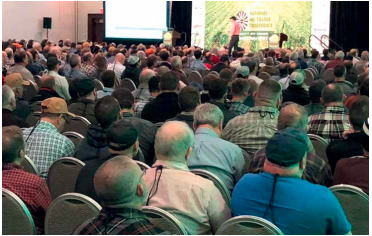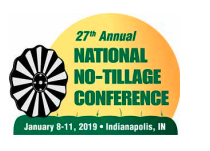Written by Ian Gould, Director of Oakbank Game and Conservation Ltd
In an attempt to take myself out of my own comfort zone and into a new learning arena, I decided to venture across the “Pond” and immerse myself in US Agriculture for a week. Arriving in Indianapolis in January 2019 I was intent on absorbing as much as I could at the US National No-Till Conference, an event that attracted almost 1000 farmers, advisors and suppliers. There was a definite bias towards Maize and Soybean growing at the event, but there was a great deal to take away that we could benefit from in the UK.
The first thing I took away was the level of interest in regenerative methods from outside agriculture. Much of this was driven by projects to protect waterways, such as the Chesapeake Bay, but also from large businesses that clearly think that there is commercial advantage to be gained by showing their environmental credentials. These include Wrangler Jeans, who are encouraging their cotton growers to use cover crops and General Mills who have started to set up strategic supply agreements with specific growers. I met a number of USDA and NRCS (Natural Resources Conservation Service) staff at the conference and they were liaising with the scientific / academic community and farmers to promote best practice.
The farmers that spoke during the event shared many of their successes and failures in some honest and informative presentations. They all spoke about how they started out in a small way without spending too much money, but wanted to see how things worked on their own farms. They all continue to trial new ideas and push the development of their own production systems.
I enjoyed the talk by Trey Hill, who farms 13,000 acres in the Chesapeake Bay watershed. He was sceptical about cover crops initially but necessity drove him to “Plant Green” one year and he has never looked back. His key learning points were that consistency in the cover crop is crucial, so that after termination the conditions are even across the field. If not, establishment of the next crop could be highly variable. Trey also mentioned that he does struggle with slugs sometimes, but this has not diminished his efforts as he has experienced so many benefits from cover cropping the land. He said that he loves his soil so much now, he never wants to see it!
Rick Clark farms 7000 acres in Indiana and he stressed the importance of keeping good data and using this effectively to make better decisions. Don’t rely on your memory as this has a habit of filtering the data over time. Rick’s mantra was “good data leads to good decisions which lead you to a position of strength.” He believes that using cover crops to “Armour the soil” gives a good return on investment.
I had been looking forward to hearing David Brandt speak as he was someone that I had watched on YouTube before travelling to the USA. David farms 1100 acres in Ohio and has been No-Till Farming since 1971 and using cover crops since 1978, so there are few more experienced growers. His standard cover crop mix contains at least 10 species, including 4 different legumes. David has long term plans for his rotation, including where the cover crops will fit in. This then feeds into the planning for herbicides, etc so that they do not run into problems with residual chemicals. David is not an organic farmer, but he certainly learns from those principles, using very little in the way of fertiliser or pesticides. Brandt says he didn’t realize microbes were so important to farming a few years ago. “But I’ve read about how vital they are, and now I see as they increase, we see more good things happening in our soil— more nutrients being released, more water infiltrating into the soil. The more microbial activity we have, the better off we are,” he says.
“I’m really intrigued with the amount of water infiltration we’re seeing with our cover crops. As we go to cover crops with deeper roots, and bigger root masses, we’re seeing rainfall dissipate through the soil better. We don’t have water pockets in our tight clay soils any more.”
Cover crops also moderate soil temperatures. “On hot summer days, with air temperatures over a hundred degrees, our neighbours had soil temperatures of 118 degrees and ours was 86 degrees. Our corn really looked great at those times,” Brandt says.
Away from the main presentations there were so many learning moments, either in the smaller breakout sessions or over a drink at the bar. I was lucky to spend a few hours with Steve Groff who is known to many as the Cover Crop Coach. Steve has worked in this area for many years and has extensive knowledge of the subject. His research led to the development of the Tillage Radish but he is now focussed on developing best practice and educating farmers and advisors around the world. His advice to all cover crop users is “know what you are trying to accomplish!” Without a clear goal, how will you ever know if you are getting anywhere.
The other key piece of advice that Steve is always giving is that when it comes to planting “Every day counts!” Be organised in good time for planting season and get the drill into the field as soon as possible after harvest. We discussed intercropping and seeding into the previous cash crop, which with some of the new drills on the market could certainly become more achievable. Steve also emphasised that the most useful tool for a cover crop farmer is his spade, get out in the field and start to investigate what is going on as “showing beats telling!”

If you are particularly interested in drills and coulter technology I would recommend looking up Loran Steinlage (@ FLOLOfarms) who has a real in-depth knowledge of the subject. I don’t imagine any equipment in his barn is still exactly as it arrived as he builds a lot of it himself or redesigns old kit. His understanding of how metal and soil interact was fascinating and I look forward to seeing what his new role with Dawn Equipment will produce. By stepping away from our normal constraints of UK thinking I have confirmed some principles that I had and certainly challenged some others. The focus on profit per acre instead of simply yield was very strong, and the stacking of enterprises (Crops + Livestock) was diversifying the income streams and spreading risk for many.
I did enjoy the positivity and openness for sharing information, despite what has clearly been a tricky time for US farmers. The massive shift into GMO Maize and Soya has led to a number of problems but it has also created opportunities for individual businesses to diversify into nonGMO markets. They are finding consumer demand for their products increasing and the most successful businesses are very close to their end markets, keeping far more of what the consumer spends within the farm business.
It was a very interesting and enjoyable trip, one that has led to continuing conversations with new friends via Skype and Social Media.
Written by James Warne of Soil First Farming
The 28th annual National NoTillage Conference will be held in St Louis from 7th to 10th January 2020.

